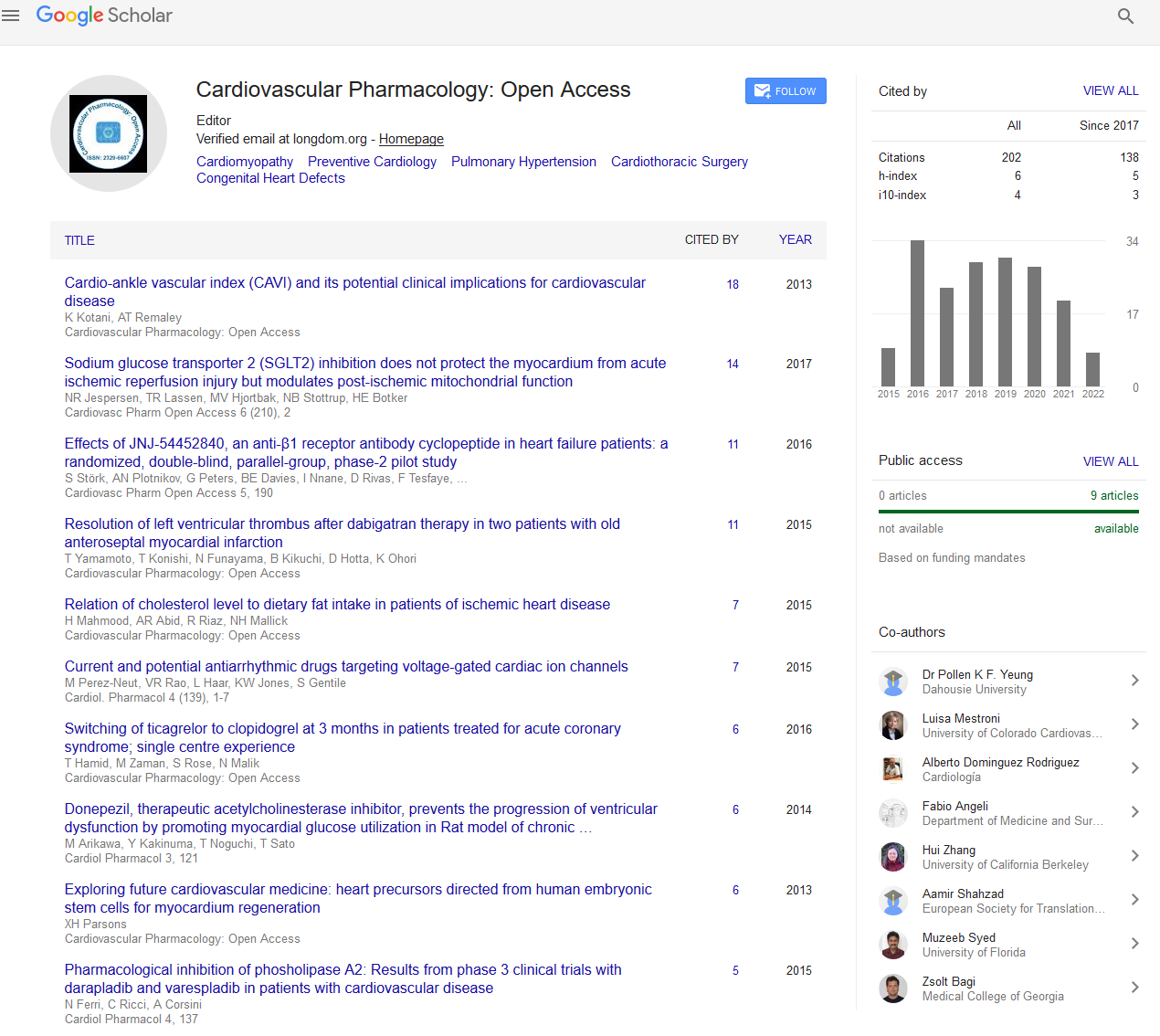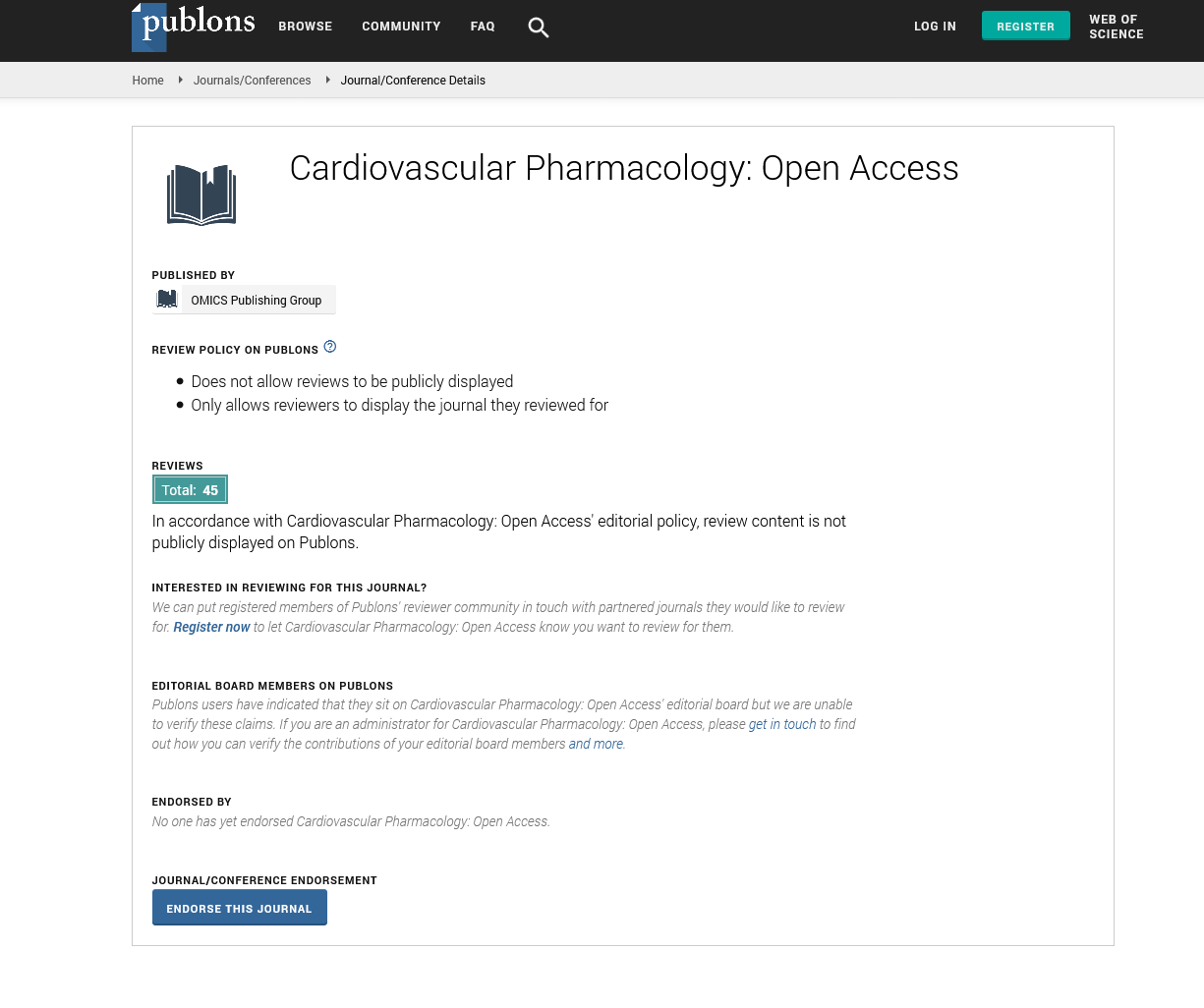Indexed In
- Open J Gate
- Cosmos IF
- RefSeek
- Hamdard University
- EBSCO A-Z
- OCLC- WorldCat
- Publons
- Geneva Foundation for Medical Education and Research
- Euro Pub
- Google Scholar
Useful Links
Share This Page
Journal Flyer

Open Access Journals
- Agri and Aquaculture
- Biochemistry
- Bioinformatics & Systems Biology
- Business & Management
- Chemistry
- Clinical Sciences
- Engineering
- Food & Nutrition
- General Science
- Genetics & Molecular Biology
- Immunology & Microbiology
- Medical Sciences
- Neuroscience & Psychology
- Nursing & Health Care
- Pharmaceutical Sciences
Perspective - (2025) Volume 14, Issue 2
The Expanding Landscape of Cardiovascular Pharmacology
Ethan Wallace*Received: 29-May-2025, Manuscript No. CPO-25-29839; Editor assigned: 31-May-2025, Pre QC No. CPO-25-29839; Reviewed: 14-Jun-2025, QC No. CPO-25-29839; Revised: 20-Jun-2025, Manuscript No. CPO-25-29839; Published: 28-Jun-2025
Description
Cardiovascular pharmacology is an evolving field that integrates physiology biochemistry and medicine to design and evaluate therapeutic agents for disorders of the heart and circulatory system. With an increasing global burden of hypertension ischemic disease arrhythmias and heart failure there has been significant attention on how medicines interact with receptors enzymes and cellular pathways to restore balance. The complexity of cardiac tissues and vascular networks demands an advanced understanding of how drugs can influence myocardial contractility conduction systems and vascular resistance. Researchers across the world continue to refine approaches to deliver better outcomes for patients living with chronic or acute cardiovascular conditions.
One of the most explored areas remains the study of drugs that influence the renin angiotensin aldosterone system. Agents such as angiotensin converting enzyme inhibitors and angiotensin receptor blockers have transformed the treatment of hypertension and heart failure by reducing vascular strain and improving cardiac efficiency. These compounds not only regulate pressure but also modify structural remodeling of the heart allowing patients to experience longer survival and improved quality of life. Alongside them mineralocorticoid receptor antagonists have shown relevance in reducing mortality among patients with advanced dysfunction.
Another important class involves beta adrenergic receptor blockers which limit the effects of catecholamine on the heart. By slowing heart rate and decreasing contractility they reduce oxygen demand and control arrhythmias. Their role extends from prevention of sudden cardiac death to enhancing survival following myocardial infarction. Calcium channel blockers add to the therapeutic armamentarium by targeting smooth muscle relaxation and influencing electrical conduction. They are widely prescribed for angina and rate control in atrial fibrillation. Nitrates too continue to be effective in relieving ischemic symptoms by enhancing nitric oxide availability and vasodilation.
Advances in pharmacology have also brought forward direct oral anticoagulants that provide safer and more predictable alternatives to traditional vitamin K antagonists. These drugs have simplified the management of atrial fibrillation and thromboembolic disease reducing the need for constant monitoring. Antiplatelet therapy also remains essential in the prevention of recurrent coronary events with newer molecules being designed for higher selectivity and fewer adverse reactions.
Lipid lowering therapy particularly statins has reshaped preventive cardiology by lowering low density lipoprotein cholesterol and stabilizing arterial plaques. In recent years additional agents such as PCSK9 inhibitors have expanded the therapeutic choices for individuals with resistant hyperlipidemia.
Emerging directions in cardiovascular pharmacology emphasize integration of molecular biology and genetics with therapeutic development. Researchers are examining ion channel modulators mitochondrial function regulators and agents influencing endothelial health. Personalized pharmacogenomics profiles may guide the selection of specific therapies ensuring greater efficacy and safety for diverse populations. Attention is also growing on the development of combination therapy that unites several mechanisms in a single formulation providing more comprehensive control of disease progression.
The global nature of cardiovascular disease has encouraged collaboration among scientists from different continents. Contributions from academic laboratories and clinical centers in the United States Japan China Germany France and Brazil among others have accelerated the pace of discovery. Pharmaceutical innovation supported by technological advances in drug delivery such as sustained release systems or targeted nanoparticles continues to extend therapeutic possibilities while also reducing systemic side effects. The integration of artificial intelligence in drug discovery adds further depth by predicting molecular interactions and identifying novel compounds more efficiently.
Despite significant progress challenges remain in addressing disparities in access to medications across countries and in managing drug resistance or adverse reactions in sensitive patient groups. Ongoing education and communication between clinician’s researchers and policy makers are vital to expand awareness about rational drug use and to develop cost effective strategies suitable for diverse health care settings. By focusing on continuous refinement of existing treatments alongside development of new pharmacological strategies the field of cardiovascular pharmacology holds an essential role in advancing patient outcomes across the globe.
Moreover, personalized medicine is emerging as a key approach to tailor therapies based on individual genetic, environmental and lifestyle factors, promising improved efficacy and safety. The growing use of big data analytics enables the identification of patient subgroups that may benefit most from specific interventions. Additionally, fostering equitable partnerships between developed and developing countries is crucial to bridge the gap in healthcare infrastructure and resource availability. These combined efforts will be critical in ensuring that breakthroughs in cardiovascular pharmacology translate into tangible health improvements for populations worldwide.
Citation: Wallace E (2025) The Expanding Landscape of Cardiovascular Pharmacology. 14:431
Copyright: © 2025 Wallace E. This is an open access article distributed under the terms of the Creative Commons Attribution License, which permits unrestricted use, distribution AND reproduction in any medium, provided the original author and source are credited.


